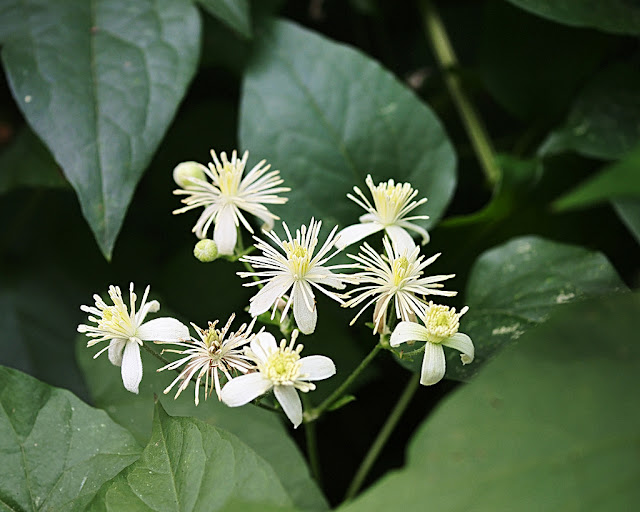Clematis
 |
| Clematis vitalba - 21 September 2016 Its similarity to an old man's beard is striking |
Clematis vitalba has colonised a number of the trees and bushes in the north of the park. In many cases, the climber has completely swamped its host, and, as in this picture, very little of the supporting tree or bush is visible, behind a bank of the invader. The appropriateness of its common name, old man's beard, is very obvious when a mass of its seed heads like this are seen.
 |
| Flowering clematis - 31 July 2016 Tree completely covered in clematis flowers. |
This plant is also commonly known as traveller's joy. This name, that has been in use since at least the 16th Century, refers to the bright and cheerful display its seeds make during the sombre autumn months. Although small greeny white flowers are quite showy, they do not have the impact of later fruit.
 |
| Clematis flowers - 24 July 2016 The flowers are unusual in that they have no petals. |
The most unusual feature of the flowers is that they have no petals; the petal like structure that can be seen in this picture are sepals. Maybe not that surprising in the wild plants, but, far more so in the cultivated plants with their huge multicoloured sepals.
 |
| Clematis and brambles - 12 September 2016 Like scavengers fighting over a corpse, brambles and clematis vie for dominance |
One of the things I have become increasingly interested in is plant communities and how plants compete for space and light. In this picture, it is hard to know what is buried below the smothering mass of brambles and clematis.
Hawthorn
 |
| Clematis and hawthorn - 11 September 2016 Contrasting seeds of hawthorn and clematis |
Given the number of hawthorn bushes in the park, it is not surprising that some have been invaded by clematis. I found the contrast of the small dense berries of the hawthorn and the fluffy white seeds of the clematis quite striking.
 | |
| Hawthorn - 12 September 2016 Hawthorn bush with a good crop of berries |
What a difference a year makes! Last year, I worked hard to find any hawthorn bush with more than a few berries. This year, every bush, like the one in this picture, was laden with them.
Rose Hips
 |
| Rose Hips - 12 September 2016 Easily missed amongst the mass of hawthorn berries |
Almost
totally lost amongst all the millions of hawthorn berries in the
park are few dog roses with their bright orange red hips. I spotted these on a bush at the north of the park.
I
was surprised how little folk lore and herbal medicine is attached to
this plant. Its medicinal use seems to be confined to use as a
source of vitamins, particularly vitamin C, when a syrup is made from
the hips.
Perhaps,
the most intriguing bit of folk lore I came across is the Indian
belief that if fairies ate rose hips and turned three times counter
clockwise, they became invisible. Eat the rose hips again, and turn
three times clockwise, and, hey presto, the fairies become visible
again.
The
rose has also been a symbol of silence since the early Egyptians.
Any matters discussed under a rose were in strict confidence. This
led to the custom of carving roses on the ceiling of banquetting
halls to remind guests that any conversations were not to be repeated
outside of the hall.
Next: Reeds
Next: Reeds






